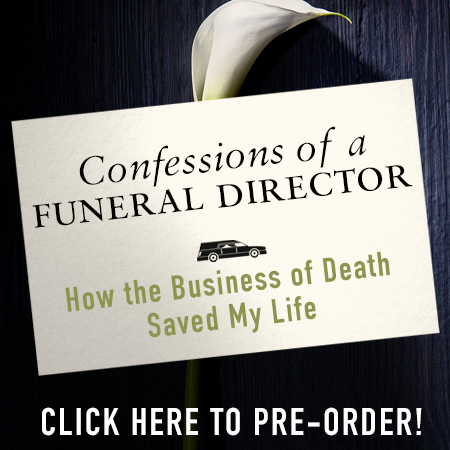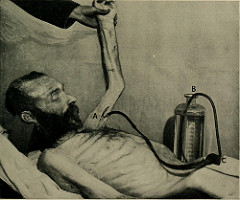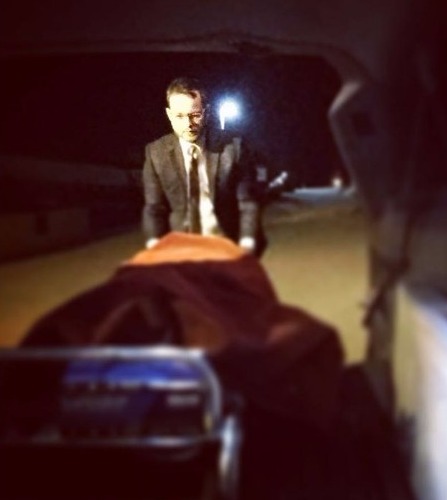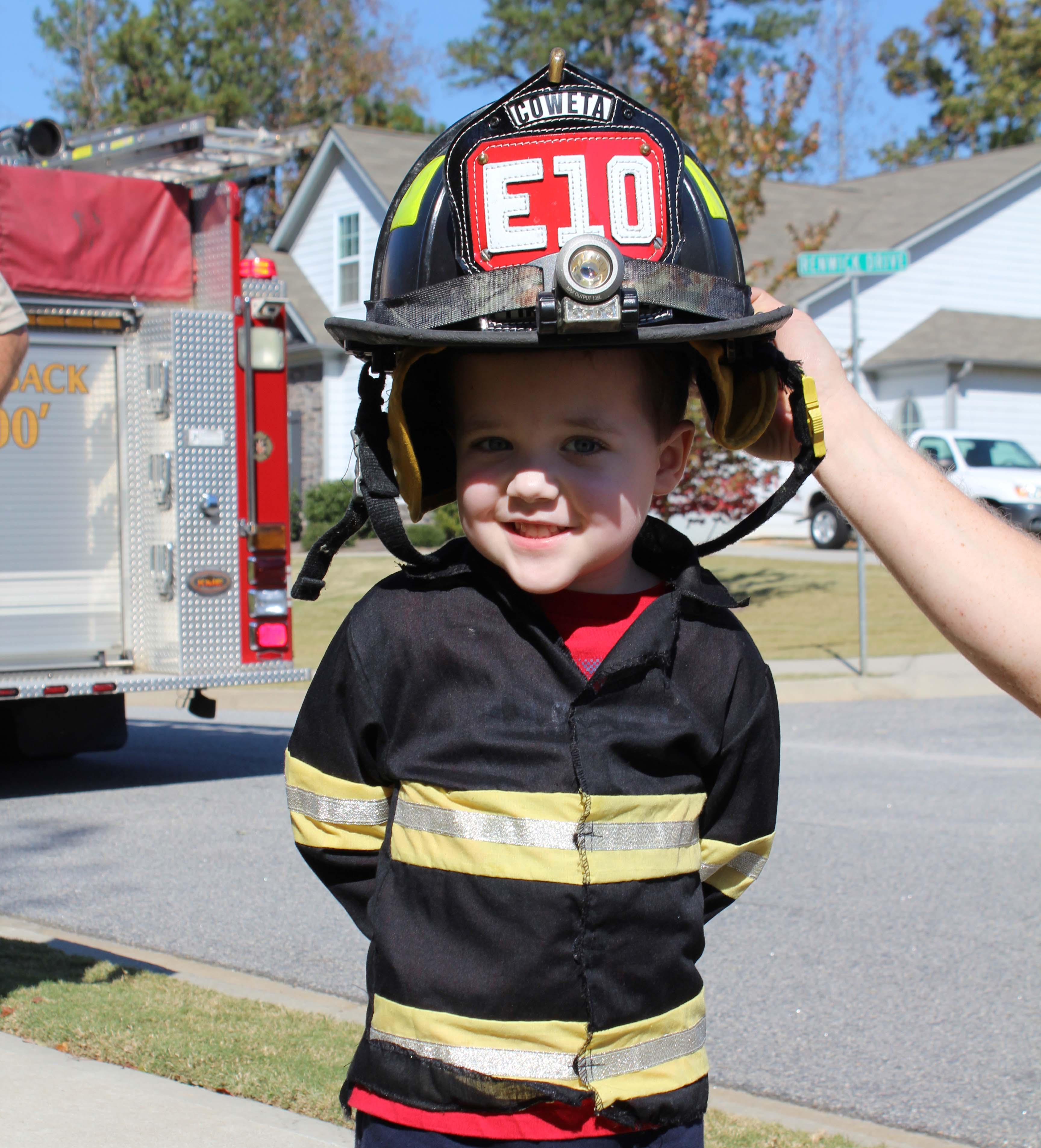Caleb Wilde
(218 comments, 980 posts)
Posts by Caleb Wilde
Let’s Stop Throwing the Dead Out with the Trash
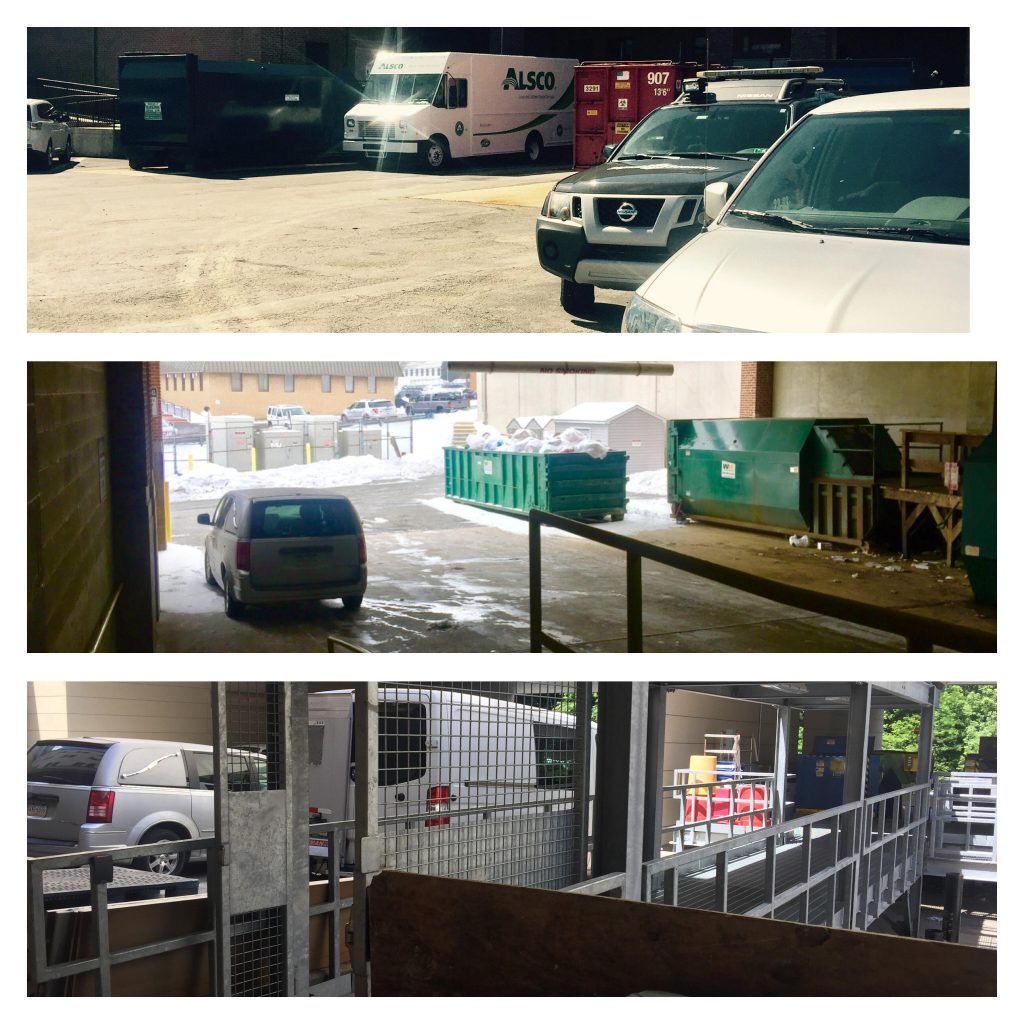
Most funeral directors will tell you that when you go to a hospital to pick up a deceased person, you’ll most likely park your removal van or hearse in the same area where the hospital throws out the trash.
The above photo montage is from three local hospitals in my area. In each case, we park the removal van at the same area where they take out the trash. Certainly, the hospitals aren’t implying that the dead are trash, but what they are implying is that both the body and the hospital’s trash should be hidden from the public view.
I want to contrast those pictures with this picture from Lisa B., who gave me permission me to share this photo:
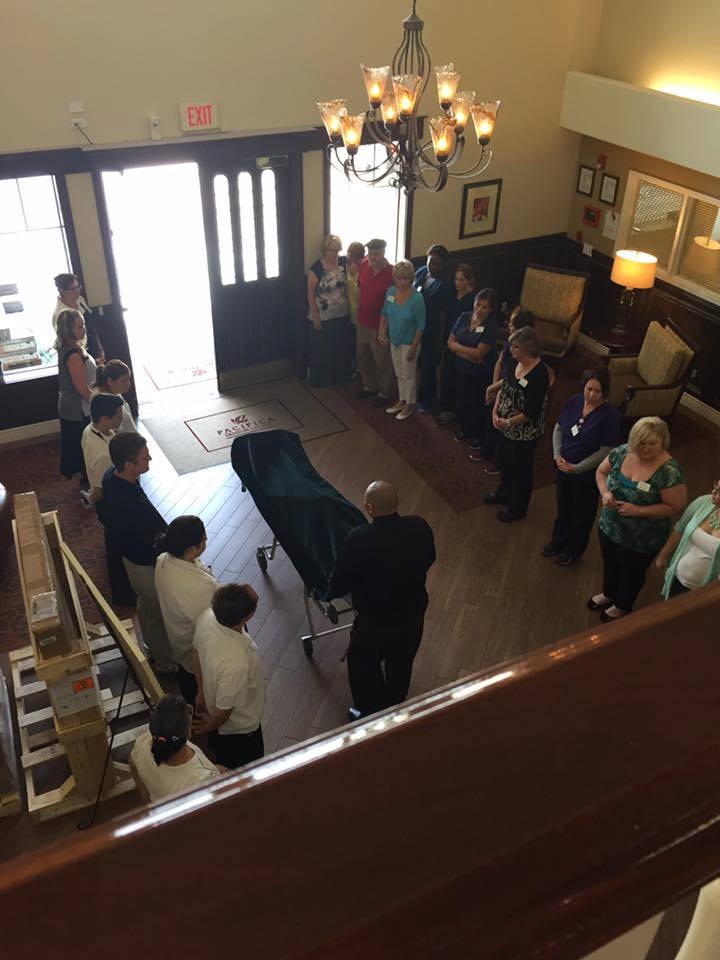
Here are the context and the backstory behind this photo:
A couple months ago I shared a beautiful experience I had at a nursing home. As I shared in that post, when we funeral directors come to remove a deceased person from a nursing home, most nursing homes have a “hide the body” mentality or a “back door policy” that ushers the deceased out the back door so no one sees it.
As I’ve come to find out, some nursing homes have a “front door policy” where the death is acknowledged and the dead honored by the nursing home and its staff. My recent experience with this “front door policy” included the nursing staff creating a walk of honor. The staff lined the hallway walls as I left the nursing home with the deceased, acknowledging the life lived and lost.
When I shared my experience with the “front door policy” and the “walk of honor”, Lisa B. shared this beautiful photo of how her grandfather’s nursing home practiced this acknowledgment of death when her grandfather died. As you can see, the staff is creating this beautiful walk of honor to acknowledge the passing of Lisa’s grandfather as he leaves the nursing home. I asked Lisa if I could share the photo with you and she gave me permission.
This act, my friends, is a beautiful step away from death denial and towards death positivity.
Nursing homes who adopt the “front door policy” deserve all the praise in the world. And I think hospitals need to take notice. I’m not suggesting that hospitals adopt a “front door policy” because I’m not so naive to think that nursing homes and hospitals are similar spaces. They are not. But, they aren’t entirely different.
Finding ways to embrace our dead, instead of hiding them, is all a part of death positivity. We don’t need to fear our dead. We don’t need to hide them. We don’t need to be ashamed of them. Instead, we need to welcome the dead into our lives and allow them spaces among the living. However that looks at a hospital, I don’t know. But I do know that sending the dead out the same door as the trash isn’t it.
If you’re interested in more stories and thoughts like this, you might like to preorder my book:
10 Things Embalmers Can’t Fix
In the world of embalming, there are a couple embalmers who are damn near miracle works. Legends of the industry. When I was in school, our embalming professor worshiped an embalmer named “Jack Adams.”
If the funeral industry had saints, Jack Adams has worked enough miracles to be canonized a couple times over. But there are only a few saints. The rest of us are just human, with limited tricks and limits to our art. And there are some things that the mass majority of us can’t fix (although some embalmers will likely differ with this list because we embalmers are a vexed and opinioned bunch). Here’s ten:
ONE. A couple years ago, a funeral director friend of mine picked up a dead man in his 60s from the hospital with black pigmented skin. The deceased’s wife was black. His children were black. And my funeral director friend assumed that the deceased was black. The day of the service the wife walked into the church to view the body and yelled, “That’s not my husband! My husband is white!” It was, in fact, her husband, but unknown to the funeral director, the drugs that were given to the dead guy by the hospital, coupled with his cause of death had stained his skin black. I thought that my friend was exaggerating, that maybe it was Formaldehyde Gray, but when I saw the pictures (that were taken for lawsuit purposes) there was nothing gray about this man’s skin. This is incredibly rare. I’ve never seen it, nor has my grandfather who has embalmed nearly 10,000 bodies, but sometimes the circumstances and the body combine for some distinct changes that embalmers can’t entirely change.
TWO. TISSUE GAS (aka Clostridium perfringens). The words that strike fear into the heart of the embalmer. Tissue gas results from an organism that duplicates itself every six minutes, causing a normal dead body to totally change in a matter of hours. Tissue gas is so contagious that if it gets on our embalming instruments, it will spread to the other bodies. It’s like the movie Outbreak but in a morgue. And once it takes over, we pray for a cure, but that prayer is rarely answered.
THREE. DISMEMBERMENT Amazingly, we can fix some kinds of dismemberment. If a person is decapitated in a clean fashion at the neck, it’s possible — although unlikely — for us to make things work. But, say a person is laying down on a train track and cut down the middle from pelvis to head, it’s possible to embalm them if we can find the arteries, but restoring them is a no-go.
FOUR. UGLY. Unfortunately, I can’t make you look like Brad Pitt or Cindy Crawford.
FIVE. DECOMPOSITION My Great Uncle (a funeral director for over 50 years) served in the Grave Registration Unit during the Korean War. His group was responsible for embalming the soldiers lost in battle. As you can imagine, some of the soldiers came back in stages of advanced decomposition, rendering arterial embalming a near impossibility. So, instead of arterial embalming, they’d do what my Uncle called “pickling”. There was a small swimming pool of embalming fluid and they’d drop the bodies in the pool and let the bodies soak until they were pickled enough to be shipped back home. As a side note, my Great Uncles entire unit would eventually die from lung cancer from breathing in the fumes of the embalming pool.
SIX. SERIOUS BURNS ON THE FACE. We can’t fix that.
SEVEN. POSTMORTEM STAIN “That doesn’t look like my son!” she yelled as she viewed her 45-year-old boy for the first time since his overdose. I had prepared her for what she was about to see. I told her that he had laid for a long time on his face. That there was distention. That we had to use opaque makeup because of the postmortem stain. That postmortem stain is very difficult to remove with embalming. And that he wouldn’t look like she remembered. “I still want to see him,” she said. And so she did.
EIGHT. SEVERE RHEUMATOID ARTHRITIS, HUNCHBACK, OR ANY OTHER SKELETAL DEFORMITY. When a person has been bedridden for an extended period of time (usually in a nursing home), their posture can suffer severe deformity from a number of causes (note: it can be caused by improper nursing care, but usually it’s simply caused by immobility). Although it’s rare, some families leave their family member in a nursing home for years on end without visiting them. And sometimes the nursing home residents can suffer deformity over the course of those years, which is an unwelcome surprise when the living family sees the deceased lying in a mangled position in a casket. We can correct some deformity, but most are skeletal and can’t be repositioned.
NINE. JAUNDICE GREEN. Normal jaundice is yellow, but when too much embalming fluid is pumped into a body that yellow turns to a Gamora colored green. Once you go Gamora, you don’t go back. We’ve created a problem we can only fix with opaque cosmetics that can look like a spray tan gone wrong.
TEN. THE ONE-THIRD RULE. Generally speaking, if one-third (or more) of the head is disfigured, it’s unlikely we can fix it. We can try. We can put hours and hours into restoration. We can piece the bones back together, wax over the deep cuts and wounds, spray the wax to get a uniform color, and maybe, just maybe, we can pull off something that resembles the deceased. Or, we can call in a miracle from Jack Adams and he can do his wonders for a couple thousand bucks.
*****
If you like my writing, consider buying my 2017 Nautilus Book Award Gold Winner, Confession of a Funeral Director (click the image to go to the Amazon page):
My Book Is Finally Here
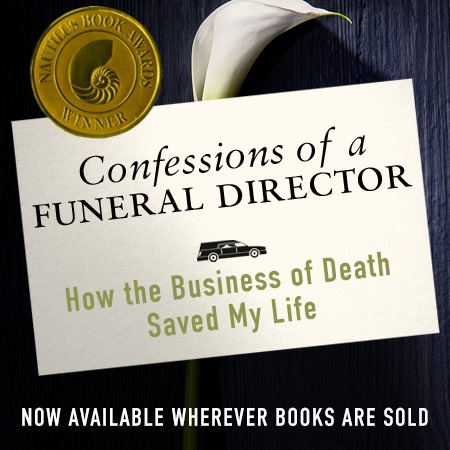
This book started as a dream some five years ago, right around the birth of my son, Jeremiah. His birth marked a distinct time in my life when I realized that I could find enough beauty in death care and enough beauty in death to sustain me as a father. When I first joined the funeral home — approximately seven years prior to Jeremiah — I was depressed, anxious and held onto a narrative about death that painted it as entirely negative. Through a number of experiences, experiences that I share in this book, that death negative narrative slowly began to change as I discovered a positive view of death that inspired me to a renewed appreciation for death care and the renewed sense that I could raise a child in this world.
Although the dream started five years ago, this book’s journey has been two years in the making. It was around July of 2015 that my agent started pitching my proposal to different publishing companies. Back in July 2015, I had a somewhat clear idea of what the book would look like, but it had yet to be written. From the beginning, it was to be a memoir that followed my journey from death to rebirth, from infertility to Jeremiah’s birth, from a death negative narrative to death positivity. But, like most memoirists, I was somewhat afraid to tell the honest truth about my life with death. I was afraid that my journey was too dark and too complicated by matters of God, death, religion, hell, and heaven for people to want to read.
I knew there’d be an interplay between my growing up around death, how my views of God affected my death negative narrative, and how my experiences in death care led to a death positive spirituality. I knew that I’d need help telling these stories in a way that was both inspiring and yet still honest about the difficulty of death. So, I was really excited when HarperOne (the spirituality imprint of HarperCollins responsible for books like The Alchemist by Paulo Coelho, Love Wins by Rob Bell and a number of other books that found a way to deal with heavier topics while still maintaining a tone of inspiration) signed me on in September of 2015.
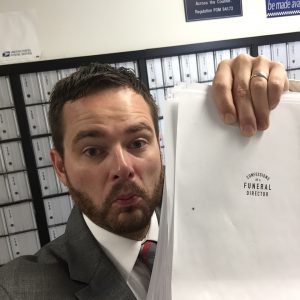
Sending the final proof to HarperOne
In the Fall of 2015, this space here on my blog became all but quiet as I started tracing my journey with the help of my wonderful editor Katy Hamilton. I kept working full-time at the funeral home, which made the writing process slower but it also kept the stories grounded and in touch with death, death care and my own personal struggles with both. It may have written a better book had I focused entirely on this book, but staying at worked helped me write compassionately from my heart about the family who lovingly dressed their deceased father for his burial. The embalming of a little girl that offered a gift back to her grieving family. The nursing home that honored a woman’s life by standing in procession as her body was taken away. The community of people with different beliefs who came together at last at a funeral. Save the introductory chapters, each chapter follows a different death story, and how that story moved me toward death positivity.
I write, as something of a thesis for the book,
“I tremble to say there’s good in death, because I’ve looked in the eyes of the grieving mother and I’ve seen the heartbreak of the stricken widow, but I’ve also seen something more in death, something good. Death’s hands aren’t all bony and cold.”
I’m both excited and nervous for this book’s release. Excited because I feel like I captured a story that will inspire, deepen and move its readers closer to embracing death and mortality. Nervous because many of these stories are written from a position of personal transparency and vulnerability.
If you’ve read my blog for a while, you may see traces of stories you’ve read here, but most of the stories are new. If you haven’t been reading my blog, the whole thing should be fresh.
Here it is. You can click HERE to go to the book’s landing page.
The 10 Hardest Parts of the Funeral Industry
Each and every job has its hard parts. Here are 10 aspects of the funeral industry that I find difficult.
One. The Silence
Silence is the voice of death. It’s antithetical to the pursuit of Americans. Most of us are programmed to want answers to our questions, truth to our doubts, words to our emptiness and meaning to our voids. But when I’m sitting with a family making arrangements for their dead loved one’s funeral, sometimes I look them in the eye, I say “I’m sorry for your loss”, and then comes the most difficult of all things: the absence of answers, the lack of truth, the void of our existence and the silence of death. We just sit, acknowledge the silence, and embrace the sacred moment.
Two. The Money
Aside from the silence, tallying up the bill is always difficult for me. It’s not that our funeral home is expensive. We pride ourselves on being the least expensive funeral home in our area. It’s not that we’re trying to rip people off. We do believe our prices are fair and honest. It’s just that bringing up money when we’re talking about death seems like sacrilege. Sure, we have to pay our bills. Sure, paychecks are good. It’s just difficult for me, and I imagine many other funeral directors as well, to capitalize on death.
Three. Flirting
Having mature women flirt with me is … not that difficult. Yeah, I actually like that part. What funeral director doesn’t mind the occasional, “If I was 40 years younger” comment?
Four. Tragic deaths
These are the kind of deaths that come home with us. You just can’t help it. There’s not a funeral director that isn’t affected by the death of a child, the car accident, the overdose or the suicide.
Five. Transference
Some people have major problems and baggage that get fanned to flame by grief and bereavement. Often times, they take their problems, their anger, their frustration and instead of dealing with their grief and bereavement, they take it out on us. If you’ve been in the business long enough, you know not to take it personally, but it’s nonetheless difficult to take a capricious verbal lashing for no apparent reason other than transference.
Six. Morticians not Magicians
There are some faces that we can’t restore.
Some bodies that are too far gone.
Sometimes it’s nearly impossible to make the dead look alive.
Sometimes, the process of securing a doctor’s signature, getting cremation approval from the county and the line up at the crematory means we can have everything finished in the time you want it to be.
I wish we had a magic wand, but there are things we can’t do. Wishing we could, but knowing we can’t isn’t an easy idea for you to accept, but it’s even more difficult for us to accept as we like to think we’re more capable than we really are.
Seven. The Night Calls
There’s no amount of coffee that can compensate for the lack of sleep caused by a 2 AM night call.
Eight. Meeting Our Own Demons
There are certain things in life, like marriage, or our kids, that have a tendency to summon our hidden demons. I’ve often said that I was a great person before I got married and then I saw just how selfish and prideful I really am. Death and the funeral industry can have a similar effect. Death culture is like the refining of gold; all of our impurities, our stress, our own anxiety, and our pride can come seeping out in the heat of the moment. But that very heat, while revealing our difficult demons, can also purify us and make us more beautiful.
Nine. Dress clothing
I like nice suits and I’m an absolute shoe addict, but wearing a suit on a sweltering mid-summer Pennsylvania day is an exquisite form of torture. I don’t believe in hell, but wearing a black suit in 100-degree weather is pretty damn close.
Ten. Personal Relationship Strain
I suppose every friend will disappoint you once in a while; but funeral directors will probably do it more often. We might miss your birthday party, we might have to leave in the middle of dinner.
Death has this way of keeping an untimely schedule. And as death’s minions, we’re tied to that schedule. Whether it be in the middle of the night, or in the middle of your wedding, when death calls, we have to respond. That respond-ability marks having a personal relationship with us somewhat difficult.
*****
If you like my writing, consider buying my 2017 Nautilus Book Award Gold Winner, Confession of a Funeral Director (click the image to go to the Amazon page):
Did My Child Die According to God’s Perfect Plan? (A Guest Post)
It’s been three years since my 4-year-old died from brain cancer, but sometimes it feels like it was yesterday. The memories can come roaring back in the blink of an eye, leaving me motionless, breathless, and aching. Sometimes I long to hold little Henry like I long for air. Even as I push forward, I encounter reminders of loss everywhere.
Two years ago we moved half-way across the country. In part, we moved to escape the reminders. We left behind the empty bedroom decorated in oranges and blues. We traveled 1,150 miles away from the library with the fountain in the front and story time on Tuesday mornings. We put days of driving between us and the pediatrician’s office with the green vinyl-covered chairs and matching industrial carpet. I left Henry’s shadows, but I can’t seem to outrun the reminders.
When I hear about a toddler being snatched and killed by an alligator, my blood runs cold. A weight sinks into my chest and doesn’t lift for hours. I know what it feels like to hear your child scream out in pain. I’ve walked through helplessness, terror, and disbelief. I know about the birthday parties his parents will never throw, the presents they won’t buy, the holidays that will feel somewhat empty and off. I understand the pain they’ll feel as they watch other children his age grow, enter kindergarten, and learn to ride their bikes without training wheels. I realize the strain that this type of loss will put on their relationships, perhaps even their identities. I know how, even years into the future, they’ll feel like something is missing when everyone is present.
When mass shootings occur and sacred lives are senselessly slaughtered, I am completely undone. I can’t seem to find words or formulate thoughts through a fog of horror and grief. My heart turns towards the loved ones facing funerals filled with polite and sympathetic conversation. Afterwards, they’ll watch as the shock fades for everyone else. The masses will disperse back into the groove of life while they instead limp forward, tired, cautious, acutely aware of the cruelty this world can dish out. There will be no going back to “normal.” Normal is forever changed. They are forever changed.
And when I come across yet another Facebook status about yet another child diagnosed with terminal cancer, I freeze. I spend a few moments locked in the painful silence of remembering, reliving, dreading for them what lies ahead. We live in a world where pain is everywhere.
Why is the world this way? How do we make sense of all this? As a Christian, I’ve turned to faith for answers. But sometimes faith can bring more questions. For example, the Bible says that God is all-powerful. Can’t God stop an alligator? Or vaporize a tumor? Scripture also says that God is love. Doesn’t God want to paralyze a gunman with murder on his mind?
Does God lack the power or the desire to prevent unspeakable pain?
I know I’m not the only one who has wrestled with this question. Some of you may have wondered: Did God lack the power or the desire to prevent my rape? My miscarriage? My cancer?
Some Christians attempt to answer these questions with phrases like “Everything happens for a reason” and “Sometimes we just can’t see what God’s doing when our eyes are blurry with tears.” Other times we’re told that suffering is “sent to refine us,” is a “blessing in disguise,” or is simply a necessary part of “God’s plan to glorify himself.”
These ideas stem from the assumption that everything is happening according to God’s perfect plan – his meticulous, divine blueprint. But I think it’s time to question that assumption.
After all, how can we call God love if God is the one orchestrating our devastation?
How can we sincerely worship a God whose glory-seeking plan requires alligator teeth in toddler flesh, bullets spraying through a crowd, or terminal brain cancer in a 4-year-old?
How could this God be considered praiseworthy? If God plans all our pain in minuscule detail, then his character doesn’t strike me as loving or praiseworthy. At best, it seems mysterious; at worst, it seems sadistic.
Finally, how do we reconcile this picture of God with God’s self-revelation in Jesus? The Bible says Jesus was the exact representation of God’s essence (Heb. 1:3). Yet when we look to Jesus’ ministry, we see a God who healed the broken… he didn’t break the healthy to glorify himself. Does God in Spirit hold a different standard of morality than his flesh-and-bones representation?
Several years ago, I began to compare God’s self-revelation in Jesus to my picture of a God who designs humanity’s suffering. That’s when I discovered a huge chasm. And during the process of engaging my questions, I found new, more satisfying answers.
Now I stand with a growing number of Christians who think it’s time for us to take another look at one of the most important questions in the world: If God is loving and all-powerful, why do we suffer? In my experience, the answer points us to a God who is more stunningly beautiful, more pure, and more loving than most of us have ever dared to imagine.
Find Jessica Kelley’s book on Amazon: Lord Willing?: Wrestling with God’s Role in My Child’s Death.
Kelley is a writer, speaker, and author of Lord Willing?: Wrestling with God’s Role in My Child’s Death, (Herald Press, April 2016). She has a B.S. in Psychology, a M.S. in Counseling & Human Development, and experience as a School Counselor. Born and raised in the South, Jessica now lives with her husband and five-year-old daughter in Saint Paul, Minnesota. She survives the absurdly long winters by going to the gym, dreaming about the beach, and eating copious amounts of chocolate. You can find her processing her faith journey at JessicaKelley.com.
